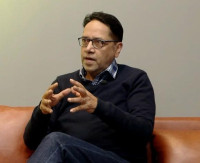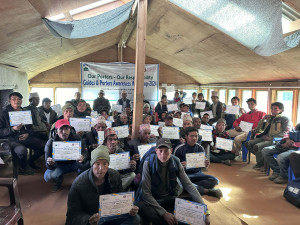Culture & Lifestyle
‘Music has no language’
Bhuchung Sherap’s latest song, ‘Achala’, is one of the few Tibetan songs from Nepal to break the language barrier and become a big hit among those who don’t understand Tibetan.
Pinki Sris Rana
When the music video for ‘Achala’ dropped on YouTube a month ago, it had all the makings of a hit single. It featured Bhuchung Sherap’s melodious voice, a catchy tune, a clever blend of traditional Tibetan musical instruments with modern ones, and a breathtakingly beautiful music video showcasing many scenic locales, including Mustang’s awe-inspiring landscape.
Even though the song is entirely in Tibetan, the majority of those who have listened to it are those who don’t understand Tibetan, making the track one of those rare Tibetan songs to come out of Nepal to have broken the language barrier. In a little over a month, ‘Achala’ has already amassed more than 417,000 views on YouTube, and the song continues to trend on social media platforms.
While ‘Achala’ might have thrust Sherap into the spotlight, the song is not his first. He released his first Tibetan song (‘Reaguk’) back in 2015. He was 18 at the time.
“I have grown a lot as a person and musician since 2015. I started by making a certain type of Tibetan songs and then branched out to doing mashup/cover songs of popular Tibetan, Hindi, and Nepali songs,” says Sherap.
The Post’s Pinki Sris Rana sat down with Sherap to discuss his musical journey, his preference for Tibetan songs and what he thinks is important to take Tibetan-language music to the next level.
Did you always want to be a singer?
I have always been musically inclined. Growing up, I loved performing on stage. So in a way, I grew up singing Tibetan songs, both traditional and modern, before an audience. When I was in my teens, I joined Nepal Tibet Opera Association at the suggestion of my music teacher, and that was where I got proper musical training. One thing led to another, and in 2015, I started my own YouTube channel, hoping to publish my own songs.
You released your debut song in 2015, but for the next few years, you mainly focused on doing cover songs. Why?
Yes, that’s true. If you look at my first few Tibetan songs, you will see that they have very few views. This is understandable because the Tibetan population is very small, and if you make music catering to just that population, the scope of growth is very limited.
When I realised that, I decided to branch out and started doing cover/mashups of popular Nepali, Hindi and Tibetan songs. Some of those songs went on to do very well, and this allowed my channel to gain traction and showcase who I am as a singer to a broader audience.
Why do you think your early Tibetan songs didn’t go on to do as well as ‘Achala’?
With my early Tibetan songs, I was trying to make the same music I grew up listening to. What I didn’t know at the time was that times have changed, and so has people’s taste in music.
From 2021, your Tibetan songs started sounding differently. What convinced you to make that musical shift?
I think it was the people I started surrounding myself with. They were the ones who inspired me to think outside the box. You see, by 2020, the world had already witnessed Spanish and Korean songs that had overcome the language barrier and become popular worldwide. It took me some time to understand that music has no language, but when I eventually did, I decided to do things differently.
I started putting in the work during the pandemic-induced lockdowns. I knew that I had to change myself as a musician and work towards creating songs that keep the Tibetan essence intact and yet are musically palatable to everyone. In a nutshell, I spent the last two years focusing on creating Tibetan songs that sound modern yet keep intact traditional elements that make our music stand out from the rest.
You said that majority of those who have watched the music video of ‘Achala’ are those who don’t speak and understand Tibetan. How was that like?
The last time I checked, around 70 percent of those who watched the song were those who didn’t understand Tibetan. This has been a humbling experience. As a musician, I think there’s no greater feeling than knowing that people connect with your music even if they don’t necessarily understand the words. When it comes to music, what matters the most is the feeling/vibe your songs can give your audience. Language doesn’t become a barrier as long as the song can give the right vibe.
You also said that you work as a cinematographer. How did that happen?
While making the video for my first Tibetan song, ‘Reaguk’, I got to know Chetan Karki, who is one of the first to start vlogging in Nepal. Through him, I met many who were into video production and interacting with them got me interested in making videos.
I realised early in this journey that being well-versed in video production would go a long way in helping me up the quality of my own music videos. When I met Jholey [Prajwol Thapa Magar], we decided to team up and start our own production unit. My mother even sold her gold jewellery to buy me a camera and all the other needed gadgets.
When I am not making music, I am busy handling video production projects, and that has allowed me to make extra income, which is always a good thing.
Coming back to music, what do you think about the Tibetan-language music landscape?
For a very long time, the majority of Tibetan-language musicians produced music that primarily catered to the Tibetan-speaking populace. But things have started changing. There’s an increasing number of musicians experimenting with different genres and creating music that is more appealing to a wider audience. One such example is the Tibetan-language rap music scene, which is growing rapidly.
These are exciting times to be a musician because language is no longer a barrier, and this goes for Tibetan musicians as well. I believe Tibetan artists ought to focus on creating contemporary music that also reflects our own musical culture. The sky is the limit as long as we follow that.




 16.12°C Kathmandu
16.12°C Kathmandu





.jpg&w=200&height=120)









